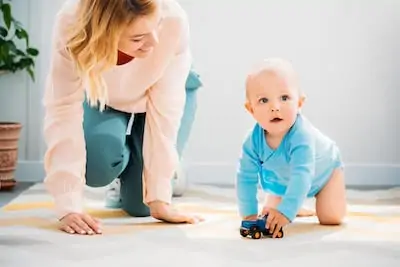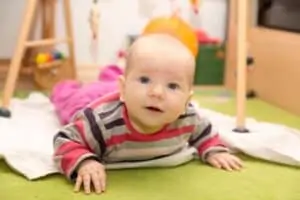Sometimes, I tell my daughters I wish I were a baby again. While most of us don’t remember our earliest days, I would always pull out old photos and ask my parents. Was I a good baby? Was I a smart baby? Did I do baby things better than other babies?
Now my kids ask me these things. Naturally.
But why do you want to be a baby again, Leslie?
I’ll tell you why. It’s because everyone makes such a fuss over all your smallest accomplishments. As an adult, this would sound truly bizarre.
“Good job, Leslie! You put the cap back on the pen so it wouldn’t dry it. Good girl!”
See what I mean?
And if I were praised for crawling, well, that’s just crazy. If you ever see me crawling, you can be assured that I’ve lost the backing to an earring or something like that.
Ah, but we’re not here to judge my ability to crawl. We’re not here to judge anyone as we learn how to teach babies to crawl. So many mamas want to get baby to crawl early, but I say let time take care of it.
That and work with the tips I’ve got below to help baby sit up and crawl. Yes, we’ve been talking a lot about crawling lately, but I like to approach topics that I’m commonly asked about. This way, I know I can help you feel comfortable in motherhood. So let’s get to it and talk more about crawling.
At what age do babies usually begin to crawl?
Newborns always remind me of the fruit in my fruit bowl on the counter. They mostly just sit there until someone picks them up. Your baby will happily sit in that baby chair or lay in the crib without a fuss in these early days. But as time speeds on, you’ll soon see the baby isn’t happy just to sit there.
And nobody puts Baby in the corner!
Sorry. I couldn’t resist. Huge Dirty Dancing fan here.

Anyway, on average, babies start crawling between 6 and 12 months. I know that’s a bit frustrating because that’s an extensive range, but every baby is different. I had friends with babies that crawled on the later end of that range while others were on the early end. And both my daughters were right in the middle of that range.
Babies don’t all crawl the same either. They may creep, scoot, roll or crawl. I wrote all about the army crawl and mentioned a few other crawling and creeping styles in there.
Don’t get too hung up on the style of crawling. Just encourage that mobility and independence while drying your tear-stained cheeks. You’ll blink those tears away, and your baby will start walking. It’s crazy!
Here’re some of the common baby crawling styles you’ll see!
When should I be concerned about my baby not crawling?
So, your baby is 6 months old, and she’s sitting up on her own. Naturally, you’re wondering when she’s going to start crawling. You have your phone in hand waiting to record that first precious crawling milestone.

Unfortunately, as this varies by baby, it’s impossible to give you a guarantee beyond that. But for now, don’t worry. I know, I know. It’s hard not to worry as a mom, but there is no reason to freak out about crawling.
With crawling, it’s very typical, though for some delays to occur. And some babies never crawl and just go straight to walking. They will pull themselves up, stand, and cruise, which is when they walk by holding onto walls, furniture, and other things.
Before you know it, you’ll be running yourself ragged chasing them around the house.
For some mamas, though, this crawling stage may be delayed by a few very common factors. Let’s discuss.
- Feet that are curved in
Some babies have flat feet, bow legs, or curved-in feet. These are common and can hold up the crawling milestone. If you notice any of these things, talk to your pediatrician. There are exercises you can do with your baby to help them.
- They’re not feeling encouraged
What’s baby’s motivation for crawling anyway? You have to put in the time with your baby to get to this milestone. More specifically, tummy time. That’s when you put the baby on her belly while you supervise. You can also show her how it’s done by crawling like a baby.
Also, when you don’t do tummy time enough (about 3 times a day in 5 to 10-minute sets), your baby isn’t developing the muscle strength she needs to move into the crawling phase. I want to encourage you to do this to help your child.

Please do not be confused with sleep time and putting the baby on her back. For sleep and to keep the risk for SIDS low, a baby must sleep on her back. But tummy time is a supervised activity. You should never leave the baby alone on her tummy during this time, and sleeping on her tummy is not advised. However, tummy time is strongly advocated by the American Academy of Pediatrics (AAP).
But wait. I know what some of you are going to tell me: “My baby cries when I put him on his belly!”
Yes, I know. Babies will cry and get upset sometimes during this activity. You can’t pick them up or soothe them every time. Instead, you’ve got to be upbeat and cheerful. Motivate your baby to help them discover their motor abilities. This physical therapy to help the baby crawl is a must for strong development.
- They’re not ready yet
As I mentioned, not every baby is ready to crawl right away. There’s no reason to panic, and do remember some babies skip this step entirely. If you’re worried, though, have a chat with your pediatrician. They will help you by checking for any problems that could have an impact on crawling. Likely, it’s just that your baby isn’t quite ready yet, and you can have peace of mind with a doctor’s approval that everything is fine.
- Choose the right clothing
Some of those baby clothes are just too cute. But they may not be helpful with allowing free movement. Choose comfy onesies for the baby during your tummy time sessions. This will let your baby move freely as needed.
- Watch for other delays
Again, if your baby is hitting other milestones and has been strengthening their neck, back, arms, and legs during tummy time, it’s likely they just aren’t ready to crawl. The time to worry is when your baby misses more than one milestone, isn’t progressing, has cognitive issues, and is stiff in and rigid with movements. For these things, you’ll want to speak with your pediatrician.
How can I help my baby learn to crawl?
Thankfully, you can teach the baby to crawl with a few tips that follow below. Ultimately, they’ll do it when they’re ready, but you may get the baby to crawl early by trying them.
Make time for tummy time
Yes, it’s that important that I must tell you yet again to do tummy time. This is strength training for your child. They build up all those muscles, which will at first help them hold up their little head. Soon, it will help them move their whole body on their own.
Set up safe spaces for crawling
Every home is different…some of us have more or less space than others. That doesn’t mean that someone with a smaller home or an apartment can’t get a baby to crawl. But regardless of your setup, please make the area safe.
Baby gates can help corral your child in a safe room or hallway in your home. Wherever you set up a safe space, make sure you have anchored furniture to a wall. Some babies skip crawling and pull themselves up. You can avoid catastrophe by taking this simple step to prevent furniture from toppling over on them.
Keep cords from electronics out of this area, cover any outlets with those outlet covers, and watch out for window coverings.
Oh! And remember what I said about crawling on the floor looking for the backing of my earrings? Please, please, PLEASE take a moment to ensure there is nothing like that on the floor of the area you choose to set up for your baby to crawl. It only takes one tiny thing like that to cause serious harm to your baby.
Use a toy to help baby crawl
Perhaps a favorite stuffed animal will lure your baby over by way of crawling. You should put it just out of their reach and encourage them to get it. See if they can get it, and don’t give up trying if they can’t.
Babies find the allure of toys an excellent motivator for moving across a room. There are all kinds of toys you can get to help with crawling like this one, for example, inflatable so you can deflate it when needed to save space. This cheerful-looking toy also seems to spark interest in crawling for babies.
Be a leader
Babies and small children love to copy what they see us do. So, why not serve as their inspiration for crawling? Show them how! Your knees will be sore (mine sure were!), but even if they can’t copy you right off the bat, they love it. They think you’re like some big, fun toy. Give it a try!
Why do babies crawl backward?
Ah, so your baby went backward while crawling, huh? No worries! This is normal. It’s a bit frustrating for the baby, too, so keep with the encouragement.
The reason they crawl backward is that they have stronger arms compared to their legs.
They wind up propelling themselves in the wrong direction. This is the perfect time to get down on all fours and crawl. Keep smiling and encouraging. Babies get scared and upset by simple things because they just don’t understand. But they feel safe and comfortable with you. If you remind them that everything is OK, they will soon feel that vibe and keep on truckin’.
Where is best for a baby to learn to crawl?

One of the last things I want to cover with teaching the baby to crawl is doing all this on a soft surface. In China, I didn’t have that luxury. Carpeted floors are not a thing.
We had one large area rug, but the tile underneath it was so hard that it hurt my knees to teach my daughters to crawl. I wound up putting padding underneath it, something like this which you can later use to set up a safe play area for your baby.
But in the US, carpeted floors are very popular. So, if possible, choose the softest carpeted area in your home for baby’s crawling adventures. And if you don’t have one just like me in China, then you can easily find an area rug to match your space or get those connecting pads to put down.
Try not to worry about crawling too much, though. In most cases, everything will work out alright. And before you know it, you’ll be exhausted trying to keep up with this child, I promise!
Leslie Berry lives with her husband and two young daughters in Los Altos, California, where she loves helping other moms get comfortable with motherhood and embracing the insanity with facts peppered with laughs.
She loves eating too much sushi, exercising, and jamming out on her Fender. Read more about Leslie here.






